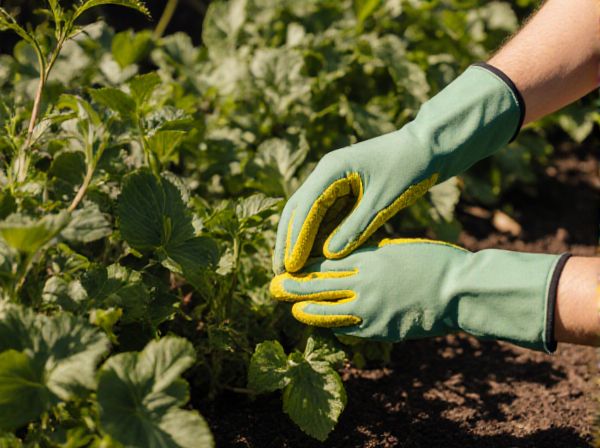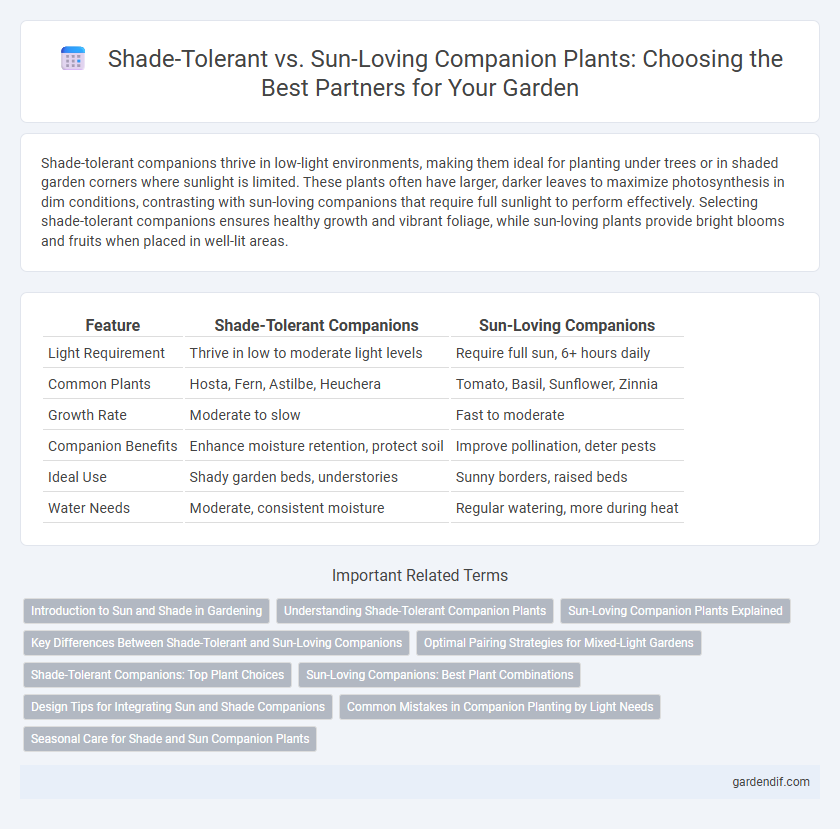
Shade-tolerant companions vs sun-loving companions Illustration
Shade-tolerant companions thrive in low-light environments, making them ideal for planting under trees or in shaded garden corners where sunlight is limited. These plants often have larger, darker leaves to maximize photosynthesis in dim conditions, contrasting with sun-loving companions that require full sunlight to perform effectively. Selecting shade-tolerant companions ensures healthy growth and vibrant foliage, while sun-loving plants provide bright blooms and fruits when placed in well-lit areas.
Table of Comparison
| Feature | Shade-Tolerant Companions | Sun-Loving Companions |
|---|---|---|
| Light Requirement | Thrive in low to moderate light levels | Require full sun, 6+ hours daily |
| Common Plants | Hosta, Fern, Astilbe, Heuchera | Tomato, Basil, Sunflower, Zinnia |
| Growth Rate | Moderate to slow | Fast to moderate |
| Companion Benefits | Enhance moisture retention, protect soil | Improve pollination, deter pests |
| Ideal Use | Shady garden beds, understories | Sunny borders, raised beds |
| Water Needs | Moderate, consistent moisture | Regular watering, more during heat |
Introduction to Sun and Shade in Gardening
Sun-loving companions thrive in full sunlight, requiring at least six hours of direct sun daily to perform photosynthesis efficiently and produce vibrant blooms. Shade-tolerant companions adapt to lower light conditions by developing larger leaves and slower growth rates, enabling survival under tree canopies or on shaded garden beds. Selecting plants based on their light requirements ensures optimal growth, maximizes garden productivity, and promotes a balanced ecosystem.
Understanding Shade-Tolerant Companion Plants
Shade-tolerant companion plants thrive in low-light conditions by adapting their photosynthesis process to maximize limited sunlight, making them ideal for understory or shaded garden areas. These plants often have broader, thinner leaves to capture diffused light efficiently and can improve soil health by supporting beneficial microorganisms in shaded environments. Selecting shade-tolerant companions helps optimize garden productivity and biodiversity when combined with sun-loving plants by balancing light requirements and minimizing competition.
Sun-Loving Companion Plants Explained
Sun-loving companion plants thrive in full sunlight, boosting growth and yields by maximizing photosynthesis. Species like basil, tomatoes, and marigolds enhance pest resistance and improve soil nutrients when paired with compatible crops. Selecting sun-loving companions requires matching plants with similar light needs to optimize garden health and productivity.
Key Differences Between Shade-Tolerant and Sun-Loving Companions
Shade-tolerant companions thrive in low-light conditions, often featuring broad leaves to maximize photosynthesis, whereas sun-loving companions require direct sunlight and typically have smaller, thicker leaves to prevent water loss. Shade-tolerant plants tend to grow slower and have adaptations such as larger chloroplasts for efficient light absorption, while sun-loving plants exhibit faster growth rates and stronger drought resistance. Choosing the right companion based on light availability ensures optimal growth, health, and biodiversity in garden ecosystems.
Optimal Pairing Strategies for Mixed-Light Gardens
Shade-tolerant companions such as ferns, hostas, and astilbes thrive alongside sun-loving plants like lavender, daisies, and tomatoes by creating layered garden designs that maximize light utilization. Strategic placement involves positioning sun-loving companions in areas with direct sunlight while integrating shade-tolerant species in partially shaded spots to maintain soil moisture and prevent heat stress. Optimal pairing enhances biodiversity, supports microclimate balance, and promotes healthier plant growth in mixed-light garden environments.
Shade-Tolerant Companions: Top Plant Choices
Shade-tolerant companions thrive in low-light environments, making them ideal for garden areas with limited sunlight. Top plant choices include hostas, ferns, and astilbes, known for their resilience and lush foliage under shaded conditions. These plants improve soil health and support biodiversity by attracting beneficial insects and providing ground cover.
Sun-Loving Companions: Best Plant Combinations
Sun-loving companions thrive in full sunlight conditions, making plants like tomatoes, basil, and marigolds ideal partners for maximizing garden productivity. These combinations benefit from mutual pest deterrence and nutrient sharing, enhancing growth and yield. Selecting sun-loving companions ensures optimal photosynthesis and robust plant health in bright garden areas.
Design Tips for Integrating Sun and Shade Companions
Designing a harmonious garden requires careful selection of shade-tolerant companions such as hostas and ferns alongside sun-loving companions like lavender and coneflowers, ensuring each plant receives appropriate light conditions for optimal growth. Strategic placement involves grouping sun-loving species in open, sunny areas while situating shade-tolerant plants under trees or structures, creating a visually balanced landscape with diverse textures and colors. Incorporating soil amendments and consistent watering schedules tailored to each plant's needs supports the health of both sun and shade companions, enhancing garden vitality and aesthetic appeal.
Common Mistakes in Companion Planting by Light Needs
Common mistakes in companion planting by light needs include pairing shade-tolerant plants with sun-loving companions, leading to poor growth due to insufficient sunlight for sun-loving species. Shade-tolerant plants such as hostas and ferns thrive in low-light conditions, while sun-loving plants like tomatoes and peppers require full sun exposure to maximize photosynthesis and yield. Ignoring these light requirements causes competition for light, resulting in weakened plants and reduced garden productivity.
Seasonal Care for Shade and Sun Companion Plants
Shade-tolerant companions require consistent moisture and protection from harsh midday sun to thrive during seasonal changes, while sun-loving companions need full sunlight exposure and well-drained soil to maximize photosynthesis. Both plant types benefit from regular pruning and fertilization tailored to their light requirements to ensure healthy growth throughout spring to fall. Adjusting watering frequency and mulch thickness helps maintain optimal soil conditions for each companion's seasonal resilience.
Shade-tolerant companions vs sun-loving companions Infographic

 gardendif.com
gardendif.com